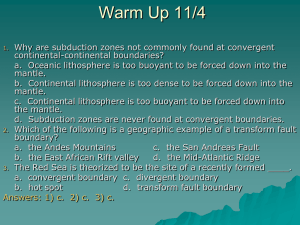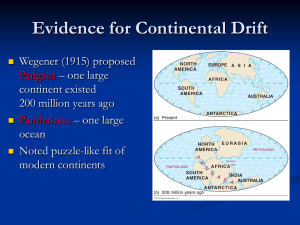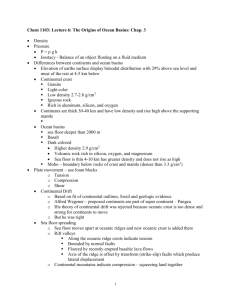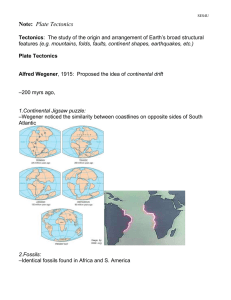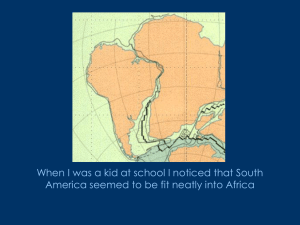2.8 Seafloor Spreading
advertisement
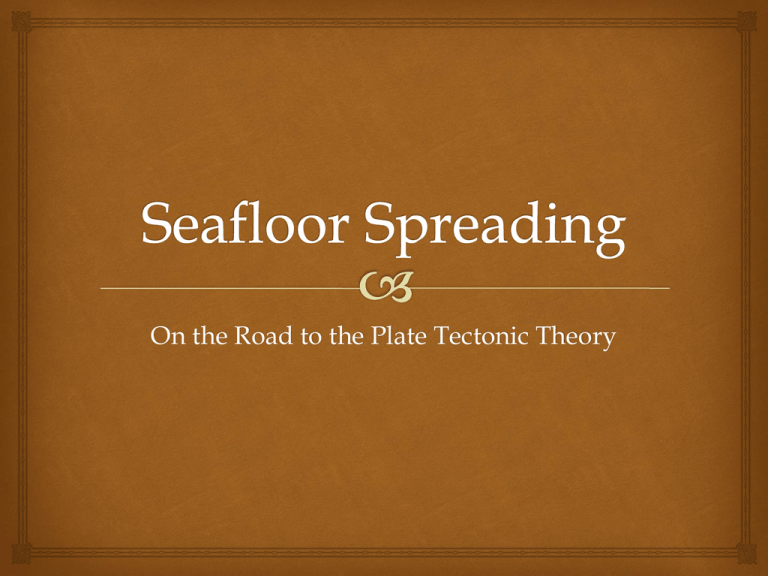
On the Road to the Plate Tectonic Theory More Background In the 1960s, several new discoveries were made due to new development in the mapping of the ocean floor. The findings showed the: Existence of an underwater mountain chain that extends around the world Presence of deep ocean trenches That the ocean floor is a relatively young age. The Oceanic Mountain Chains These mountains outrival all mountain chains on land These mountains are not like the mountains we find on most continents. The chain extends for some 65,000 km in all oceans and are 1500 km wide. The chains are known as “mid-ocean ridges”, and new sea floor is being created by volcanic activity Lava eruptions from the mid-oceanic ridges takes place from rifts in the ocean ridge. This process creating a new seafloor creates a spreading as the older lava is pushed to either side of the rift. Oceanic Trenches were later related to areas where geological destruction is occurring. These two ideas known as Seafloor Spreading and that of Wegener’s Continental Drift Theory were amalgamation that form what is now known as the Plate Tectonic Theory The Evidence Paleomagnetism – the study of the Earth’s ancient or fossil magnetic field. Fossil magnetism can be detected in rocks by using an instrument called a magnetometer How Does Paleomagnetism Work The Earth is essentially dipolar (two poles), like a bar magnet with a North and South Pole. The magnetic field generated is believed to be created from the liquid outer core of the Earth. The magnetic field create lines of force, which are not visible to the eye but can be detected by small magnets When rock is molten (lava or magma), magnetic minerals (containing iron) in the molten material are randomly oriented With solidification of the molten materials, the magnetic minerals (or fossilized compasses) will align themselves with the Earth’s lines of force. Using a magnetometer on a solid rock can give us two pieces of information at the time of crystallization The direction of the North Pole The angle of magnetic dip. This information combined together can tell us what latitude that rocks were formed. This in turn has told us that land masses have moved. An example is that there are rocks in part of Nova Scotia that indicate they were formed at latitude 0º, the equator, yet the location is presently sitting at 45º North The Other Discovery Further paleomagnetic studies of rocks have also indicated that the North Pole is in a different location today from where it was in the past The moving of the poles is termed apparent polar wandering The study of the ocean floor by paleomagnetism revealed more information. An invisible striped of high and low magnetic intensity on the ocean floor. Rock with patterns of high or positive magnetic intensity that are aligned with the Earth’s magnetic field of today are referred to as normal polarity. Rocks of low or negative magnetic intensity, which are opposite direction of present day are termed reversed polarity. This pattern on the ocean floor means that the Earth’s magnetic poles have revered a number of times over the Earth’s history. The stripped pattern also being symmetrical about the oceanic ridge supported seafloor spreading hypothesis Later drilling of the ocean floor confirmed that the youngest ocean rocks are centered on the ridge and get progressively older as one moves away form the ridge in either direction.
